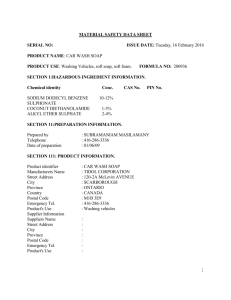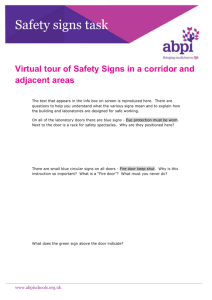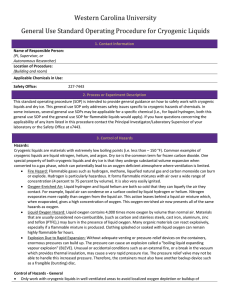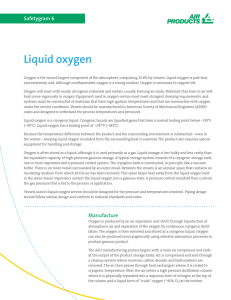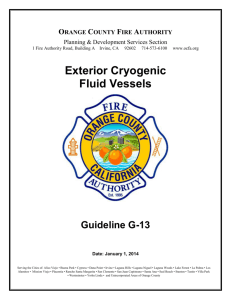RISK ASSESSMENT FOR LAB 7 WORKSHOP
advertisement
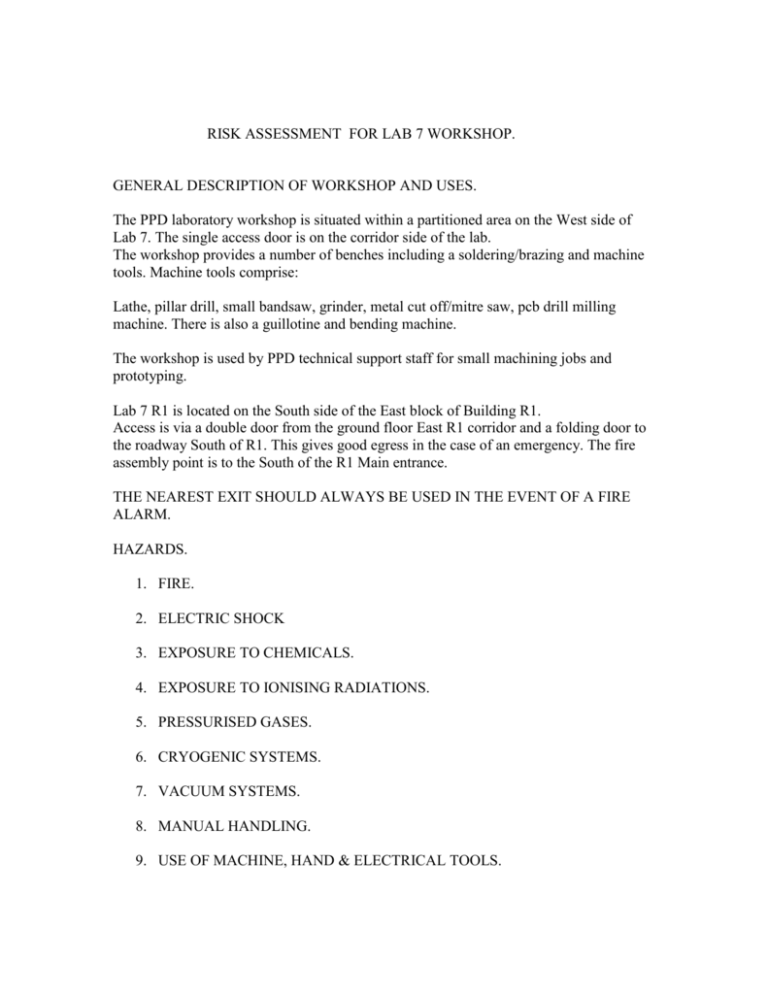
RISK ASSESSMENT FOR LAB 7 WORKSHOP. GENERAL DESCRIPTION OF WORKSHOP AND USES. The PPD laboratory workshop is situated within a partitioned area on the West side of Lab 7. The single access door is on the corridor side of the lab. The workshop provides a number of benches including a soldering/brazing and machine tools. Machine tools comprise: Lathe, pillar drill, small bandsaw, grinder, metal cut off/mitre saw, pcb drill milling machine. There is also a guillotine and bending machine. The workshop is used by PPD technical support staff for small machining jobs and prototyping. Lab 7 R1 is located on the South side of the East block of Building R1. Access is via a double door from the ground floor East R1 corridor and a folding door to the roadway South of R1. This gives good egress in the case of an emergency. The fire assembly point is to the South of the R1 Main entrance. THE NEAREST EXIT SHOULD ALWAYS BE USED IN THE EVENT OF A FIRE ALARM. HAZARDS. 1. FIRE. 2. ELECTRIC SHOCK 3. EXPOSURE TO CHEMICALS. 4. EXPOSURE TO IONISING RADIATIONS. 5. PRESSURISED GASES. 6. CRYOGENIC SYSTEMS. 7. VACUUM SYSTEMS. 8. MANUAL HANDLING. 9. USE OF MACHINE, HAND & ELECTRICAL TOOLS. 10. SLIPPING/TRIPPING HAZARDS. GROUPS OF PEOPLE AT RISK FROM THESE HAZARDS. 1. LABORATORY STAFF 2. CLEANERS 3. STUDENTS – INEXPERIENCED STAFF 4. MAINTENANCE PERSONNEL 5. VISITORS 6. LONE WORKERS CONTROL OF RISKS 1. FIRE There is a risk of fire from flammable materials such as chemical solvents and stored paper, wood and packaging materials. Flammable solvents should not be used in the presence of naked flames or equipment which may cause sparks. Flammable solvents should only be used and stored in small quantities, storage must be in the metal cabinet marked “Flammable”. The risk of fire from the ignition of paper, wood or packaging materials should be minimized by keeping it to the minimum required and by good housekeeping. Soldering irons should be kept clear of combustible materials and always turned off after use. The workshop has a smoke detector installed, it will give a Building fire alarm if triggered. A fire extinguisher is provided just outside the workshop door. Exit doors, walkways and fire extinguishers should be kept clear of obstructions in case of fire. All staff should be conversant with the use of fire extinguishers and what to do in the event of a fire alarm. This is covered by staff training. 2. ELECTRIC SHOCK The risk of electric shock is principally from damaged wiring on portable electrical equipment or work on apparatus with exposed mains or high voltage terminals. Portable electrical equipment is inspected or tested every year so risk of electric shock should be minimal but users should be wary of damage to wiring or plugs during use. Persons working on equipment with exposed mains or high voltage should be competent to do so and should never do the work alone. Where High voltage equipment is used there must be a “Danger High Voltage” sign displayed. 3. EXPOSURE TO CHEMICALS. Chemicals covered by COSHH regulations are kept in a steel cupboard and COSHH assessment sheets are provided for all chemicals in the cupboard covered by these regulations. Users should acquaint themselves with the information appropriate to a chemical before use. Precautions should be taken to avoid spillage and rubber gloves and goggles worn where appropriate. If gases covered by COSHH regulations may be released in any process then the appropriate exposure limits should observed, if this cannot be guaranteed then the process may not be carried out except in a fume cupboard. Chemicals must be kept in appropriate containers and labeled correctly including the COSHH hazard notice if required. 4. EXPOSURE TO IONISING RADIATIONS. Radioactive sources may be kept in this laboratory, there is a warning notice on the main entry door. The sources are kept in lead shielded containers where necessary . They are labelled with type, registration number and activity. They are all kept in a labeled steel cupboard. They should only be removed for use by authorized persons acquainted with the laboratory radiation safety code. A warning notice should be displayed wherever a source is being used noting the type of source, activity and dose rate at working distances. Access to the laboratory should be restricted to authorized persons when a source is in use. There should be no contamination risk from the sources as they are normally sealed and wipe tests are carried out every year. It is absolutely prohibited to interfere with the packaging of any radioactive source. Film badges must be worn at all times when a source is being used. Radioactive sources are all registered with the Health and Safety group who carry out regular checks on them, all movements of sources within or outside the laboratory must be notified to the Health and Safety group and sources must not be brought into the laboratory from an external supplier without reference to them. 5. PRESSURISED GASES. Pressurised gas cylinders should normally be stored outside the laboratory except when in use. They should always be use with the correct pressure regulator which should also carry it’s issue date. Regulators should be returned to stores for recycling after 3 years of heavy use or 5 years of light use. Gas cylinder stands of approved type should always be used for holding cylinders and correct manual handling techniques used for moving them (sect 8). Connecting tubing should be certified to withstand the operating pressure and any pressure vessel in use must be a registered unit. Flammable gases must have appropriate containment in case of leaks which should be vented externally. Flammable gas detectors which give an audible warning and shut down the supply at the detection of an explosive gas mixture must be in use. Signs must be placed to advise persons of the use of flammable gas and warn against naked flames in the area. 6. CRYOGENIC SYSTEMS. Cryogenic liquids (mainly liquid nitrogen) should only be handled by persons familiar with handling precautions. Suitable gloves and goggles should always be used during transfer operations. Particular care should be taken when discharging liquid from self pressurising dewars, inform persons locally that a transfer operation is about to take place and open valve slowly. Contact with cryogenic liquid can cause severe burning to the skin. Any vessel containing cryogenic liquid should not be sealed unless there is a pressure relief system in operation to avoid explosions. Dewars issued from stores which may be pressurized for liquid transfer have a pressure relief valve set to 1 Bar and a bursting disk for protection. RAL stores dewars are inspected and tested every year. In confined spaces the release, accidental or in the course of an operation of large quantities of liquid nitrogen may lead to serious oxygen depletion. Users should be aware of this and if necessary do a calculation of oxygen depletion knowing the boil off rate of the liquid. If there is any doubt an oxygen depletion meter with alarm should be used. 7. VACUUM SYSTEMS. There is generally little risk from vacuum systems although the following points should be noted. The exhaust from rotary pumps should be vented outside the laboratory. There may be a case for fitting an oil mist filter if large volumes are regularly pumped or gas ballast is often used. Glass systems must have some protection against implosion. Glass dessicators are supplied with mesh cages which should always be used when evacuated. 8. MANUAL HANDLING. Generally persons should avoid the lifting of heavy objects unless some mechanical aid is available, for instance the use of gas bottle trolleys for the movement of gas cylinders. The heavy gang should be booked if there is any doubt about the ability of person or persons to move heavy equipment. All staff should have attended the manual handling course arranged by the Health and Safety group. 9. USE OF HAND, MACHINE AND ELECTRICAL TOOLS. All persons using hand, machine and electrical tools should be competent to use them. There is a list posted on the workshop door of persons authorized to use the machine tools. No other person may use the machine tools except under the supervision of one of the named users. The workshop should normally be kept locked and the machine tools locked off at the mains isolator. Inexperienced personnel or students may need some training and supervision. Tools should only be used for the jobs they are intended for and should be in good condition. Guards are provided on the machine tools, these must not be removed or tampered with. Goggles are provided and should be used where appropriate. 10. SLIPPING / TRIPPING HAZARDS. Walkways and doorways should be kept clear of obstructions and trailing leads should be discouraged or covered with tapered matting. Oil or liquid spillages should be cleaned up as soon as possible. Where cleaning has left a wet floor a warning notice should be displayed. CONCLUSIONS. users of Lab 7 workshop must be conversant with the safety and other regulations issued by the Laboratory on the following documents :RALSC3 Electrical safety RALSC8 Use of portable electrical equipment HSN3 Apparatus left working during silent hours HSN29 Fire prevention HSN41 Safety of visitors HSN47 Personnel working alone. GENERAL Signs and warnings. A.L.Lintern 9-5-95 Revised 22-5-03 PERSONS AUTHORISED TO USE LAB 7 WORKSHOP. G.J.Alner R.Holt R.J.Apsimon E.L.Johnson T.J.Durkin A.L.Lintern P.S.Flower R.M.Preece M.D.Gibson M.Sproston D.L.Hill J.H.Williams
